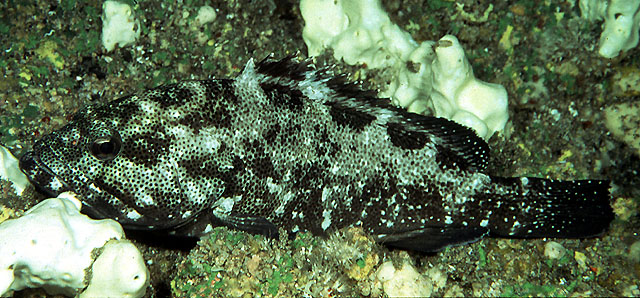| Epinephelidae (Groupers) |
| 52 cm TL (male/unsexed) |
|
reef-associated; marine; depth range 0 - 10 m |
| Pacific Ocean: islands of Oceania; Ogasawara Islands, Marcus Islands, Mariana Islands, Marshall Islands, Phoenix Islands, American Samoa, Cook Islands, Line Islands, Society Islands, Rapa, Tuamoto Islands, and the Pitcairn Group. Unknown in Hawaii, the Marquesas, Caroline Islands, nor in any Melanesian islands. |
|
Dorsal spines (total): 11-11; Dorsal soft rays (total): 14-16; Anal spines: 3-3; Anal soft rays: 8-8. Preopercle rounded, finely serrate; upper edge of the operculum sinuous; nostril subequal; maxilla reaches past vertical at rear edge of the eye. Pectoral fins fleshy. Head and body whitish, with small close-set blackish-brown spots, those on the rear part of the body coalesced to form irregular longitudinal bands. Four dark blotches usually at the base of the dorsal fin and a fifth forming a dark saddle blotch on the peduncle. Fins with small white spots and whitish margins, usually with a black submarginal band; body depth contained 2.9-3.4 times in SL; head length 2.4-2.6 times in SL (Ref. 89707). |
| This shallow-water species is more common on atolls than high islands, and usually found in exposed outer-reef areas. Not dependent on coral cover (Ref. 89707). Juveniles and occasionally adults are collected from tide pools. Feeds on crustaceans (mainly grapsid crabs), octopi, and fishes. |
|
Least Concern (LC); Date assessed: 21 November 2016 Ref. (130435)
|
| harmless |
|
Source and more info: www.fishbase.org. For personal, classroom, and other internal use only. Not for publication.

